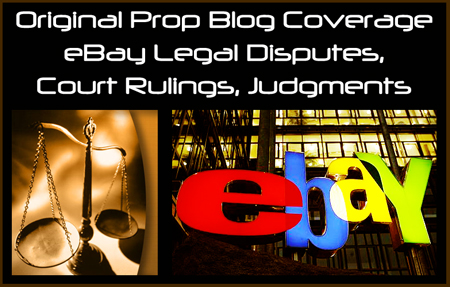As touched on in a related report two weeks ago (see French Court Orders eBay to Pay $61 Million for Sale of Counterfeit Goods), TIffany & Co. initiated a lawsuit against eBay with regard to the high number of counterfeit Tiffany goods being sold on the auction website. The U.S. District Court judge in New York ruled yesterday that eBay Inc. fulfilled its legal obligation and took adequate precautions to block the sale of counterfeit jewelry on its site. This marks a significant victory for eBay in battling luxury companies suing the auction giant for not effectively policing its e-commerce website for fraud.
Per a Wall Street Journal article (see EBay Wins Tiffany Case Over Counterfeit Goods), eBay’s spokeswoman said:
Today’s decision is a victory for consumers. The ruling confirms that eBay acted reasonably and has adequate procedures in place to effectively address counterfeiting. The ruling appropriately establishes that protecting brands and trademarks is the primary burden of rights owners. While today’s decision is a victory for consumer choice, it is a shame that so much effort has been wasted when Tiffany could have worked with eBay to more effectively fight counterfeits. eBay will continue to lead the industry with innovative solutions to stop the sale of counterfeits.
Below is a PDF of the ruling (66 pages):
TIFFANY (NJ) INC. AND TIFFANY AND COMPANY versus EBAY, INC.
Ruling Excerpt:
Tiffany acknowledges that individual sellers, rather than eBay, are responsible for listing and selling counterfeit Tiffany items. Nevertheless, Tiffany argues that eBay was on notice that a problem existed and accordingly, that eBay had the obligation to investigate and control the illegal activities of these sellers – specifically, by preemptively refusing to post any listing offering five or more Tiffany items and by immediately suspending sellers upon learning of Tiffany’s belief that the seller had engaged in potentially infringing activity. In response, eBay contends that it is Tiffany’s burden, not eBay’s, to monitor the eBay website for counterfeits and to bring counterfeits to eBay’s attention. eBay claims that in practice, when potentially infringing listings were reported to eBay, eBay immediately removed the offending listings. It is clear that Tiffany and eBay alike have an interest in eliminating counterfeit Tiffany merchandise from eBay – Tiffany to protect its famous brand name, and eBay to preserve the reputation of its website as a safe place to do business. Accordingly, the heart of this dispute is not whether counterfeit Tiffany jewelry should flourish on eBay, but rather, who should bear the burden of policing Tiffany’s valuable trademarks in Internet commerce.
Having held a bench trial in this action, the Court issues the following Findings of Fact and Conclusions of Law, as required by Rule 52(a) of the Federal Rules of Civil Procedure. Specifically, after carefully considering the evidence introduced at trial, the arguments of counsel, and the law pertaining to this matter, the Court concludes that Tiffany has failed to carry its burden with respect to each claim alleged in the complaint. First, the Court finds that eBay’s use of Tiffany’s trademarks in its advertising, on its homepage, and in sponsored links purchased through Yahoo! and Google, is a protected, nominative fair use of the marks.
Second, the Court finds that eBay is not liable for contributory trademark infringement. In determining whether eBay is liable, the standard is not whether eBay could reasonably anticipate possible infringement, but rather whether eBay continued to supply its services to sellers when it knew or had reason to know of infringement by those sellers. See Inwood Labs., Inc. v. Ives Labs., Inc., 456 U.S. 844, 854 (1982). Indeed, the Supreme Court has specifically disavowed the reasonable anticipation standard as a “watered down” and incorrect standard. Id. at 854 n.13. Here, when Tiffany put eBay on notice of specific items that Tiffany believed to be infringing, eBay immediately removed those listings. eBay refused, however, to monitor its website and preemptively remove listings of Tiffany jewelry before the listings became public. The law does not impose liability for contributory trademark infringement on eBay for its refusal to take such preemptive steps in light of eBay’s “reasonable anticipation” or generalized knowledge that counterfeit goods might be sold on its website. Quite simply, the law demands more specific knowledge as to which items are infringing and which seller is listing those items before requiring eBay to take action.
The result of the application of this legal standard is that Tiffany must ultimately bear the burden of protecting its trademark. Policymakers may yet decide that the law as it stands is inadequate to protect rights owners in light of the increasing scope of Internet commerce and the concomitant rise in potential trademark infringement. Nevertheless, under the law as it currently stands, it does not matter whether eBay or Tiffany could more efficiently bear the burden of policing the eBay website for Tiffany counterfeits – an open question left unresolved by this trial. Instead, the issue is whether eBay continued to provide its website to sellers when eBay knew or had reason to know that those sellers were using the website to traffic in counterfeit Tiffanyjewelry. The Court finds that when eBay possessed the requisite knowledge, it took appropriate steps to remove listings and suspend service. Under these circumstances, the Court declines to impose liability for contributory trademark infringement.
Third, the Court finds that Tiffany has failed to meet its burden in proving its claims for unfair competition. Fourth, in regard to Tiffany’s claim for false advertising, the Court concludes that eBay’s use of the Tiffany trademarks in advertising is a protected, nominative fair use of the marks. Finally, the Court finds that Tiffany has failed to prove that eBay’s use of the TIFFANY Marks is likely to cause dilution. Even assuming arguendo that Tiffany could be said to have made out a claim for trademark dilution, the Court finds that eBay’s use of the marks is protected by the statutory defense of nominative fair use.
Accordingly, the Court hereby enters judgment for eBay. The Court’s judgment is supported by the following Findings of Fact and Conclusions of Law.
Reading the full document, it seems as though eBay presented evidence in court as to efforts on their part to monitor their site and combat fraud. Of course, policies and procedures in the abstract and how consistently they are employed with success in practice can be two different things.
I will continue to monitor these and related events.
Past articles published by the Original Prop Blog related to other legal disputes and court proceedings can be found via the portal below:
Jason De Bord


